Officer and Laughing Girl
c. 1657–1660Oil on canvas
50.5 x 46 cm. (19 7/8 x 18 1/8 in.)
Frick Collection, New York
Vermeer must have owned several hats. No document mentions this, but no Dutchman of his generation and status went out in public bareheaded. Take a look at the people in the foreground of View of Delft, and you will see that everyone, male and female, has a hat or head covering. A poor man made do with wearing a slouch cap known as a klapmuts, but the better sort flaunted the kind of hat we see in Officer and Laughing Girl. We should not be surprised to see the officer wearing his lavish creation indoors. When Vermeer painted a man without a hat, he was someone at work: a music teacher or a scientist. A courting man did not go hatless. The custom for men to remove their hats when entering a building or greeting a woman (a custom generally forgotten today) was not yet being observed. The only person before whom a European gentleman bared his head was his monarch, but as Dutchmen prided them selves in bowing to no monarch and scorned those who did, their hats stayed on. Vermeer himself wears hats in the two scenes into which he painted himself. In his cameo appearance as a musician in The Procuress, he wears an extravagant beret that slouches almost to his shoulder. In The Art of Painting ten years later, he wears a much smaller black beret, even then the distinguishing badge of the artist.
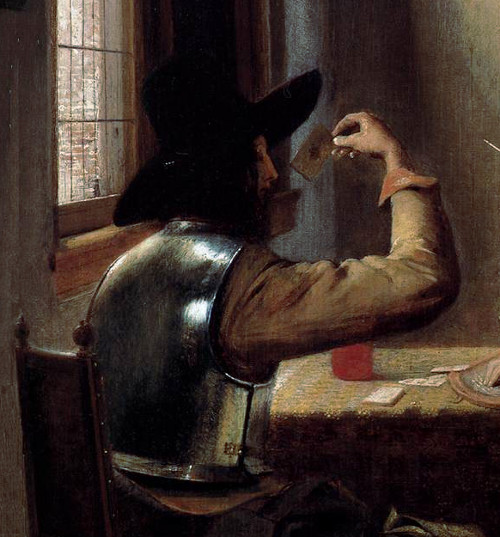
Pieter de Hooch
c. 1657–1658
Oil on wood, 55.5 x 45.7 cm.
Private Collection, Zurich
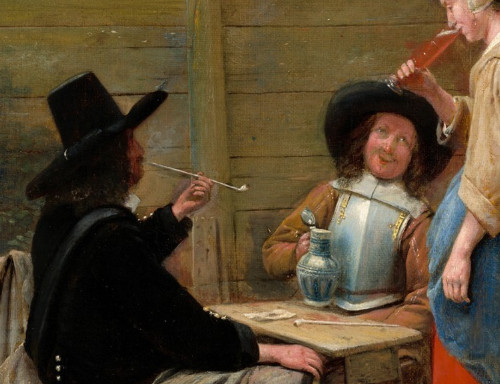
Pieter de Hooch
1658–1660
Oil on canvas, 69.5 x 60 cm.
National Gallery of Art, Washington D. C.
Vermeer had other social roles to play, and so needed other costumes in which to play them. He enjoyed the gentlemanly prestige of being a "marksman" in the Delft militia, though there is no evidence he knew how to use a firearm. A pike, breastplate, and iron helmet appear in the inventory of his possessions that wife Catharina Bolnes drew up after his death as a deposition in her application for bankruptcy, but there is no gun, and no military costume. To judge from the many portraits from the period showing Dutch gentlemen in such costume, he would have needed a grand felt hat of just the sort the soldier in Officer and Laughing Girl is wearing. A beret would have been considered flippant, and an iron helmet was uncomfortable to wear and only donned for combat. Being a militiaman involved a certain social distinction that one had to maintain by dressing properly, so Vermeer must have owned a hat like the one we see in Officer and Laughing Girl.
What we don't know is whether he owned that particular hat. There is no sign of one in the posthumous inventory, but as hats of this sort were expensive and Catharina was desperately short of cash, she might well have sold it in the two and a half months between his death and her filing for bankruptcy protection. What we do know is that there was a hatter in the family. Dirck van der Minne, the uncle who had a son and two grandsons in the East Indies when his will was read in 1657, was a felt maker and hatter. Perhaps Uncle Dirck made hats for Vermeer. Perhaps we are looking at one of them in Officer and Laughing Girl.
One of Vermeer's most glowing paintings is the Officer and Laughing Girl. The light that floods the corner of the room where the couple sits is given a particular intensity by the silhouetted figure of the soldier. His black hat and red jacket form a striking contrast to the light background and yellow-green tablecloth. The girl, who leans forward slightly in her chair and smiles at the soldier, is vividly portrayed in a yellow and black jacket.
Because the costume of the girl and the painting techniques (fig. 1) resemble those of the Girl Reading a Letter at an Open Window, this painting is generally dated about 1658, shortly after the other. The differences in mood between these works are substantial: whereas the Girl Reading a Letter is quiet and restrained, this work is exuberant and stresses momentary action. The shift of emphasis may be due to Vermeer's close contact with Pieter de Hooch. De Hooch, during the mid-1650s, painted a number of interior genre scenes of soldiers and women at tables. In some of these (fig. 2), he also tended to situate the soldier so that the viewer peered over his shoulder; this viewpoint gave an informal appearance to the scene.

Johannes Vermeer
c. 1657–1659
Oil on canvas, 83 x 64.5 cm.
Gemäldegalerie Alte Meister, Dresden
Although Vermeer seems to have adopted his subject matter from De Hooch, his conception of the scene is quite different. Vermeer brought his figures extremely close to the picture plane. He heightened the contrast of scale between the two figures and intensified contrasts of light and color. The effect is comparable to that seen in a wide-angle lens or convex mirror. Vermeer may have become interested in optical devices through an association with Fabritius, and apparently sought to capture the expressive character of their images in this work.

c. 1657–1658
Oil on wood, 55.5 x 45.7 cm.
Private Collection, Zurich
If Vermeer did experiment with an optical device, he did not recreate its image exactly. The architecture of the room is constructed according to the laws of linear perspective. The rapidly receding orthogonals of the window frame draw one quickly back into depth. The perspective, moreover, is designed to reinforce the bonds between the two figures. The vanishing point of the window is located midway between the eyes of the soldier and the woman. Vermeer did make one modification in the perspective scheme: he drew the man's chair so that its orthogonals recede to a higher horizon than that of the rest of the room. By doing so, he enhanced the contrast in scale between the soldier and the girl.
This painting contains one of the first examples of Vermeer's precise sense of realism: the map on the back wall. Wall maps, which were popular forms of decoration in Vermeer's day, are frequently found in his paintings. This map of Holland and West Friesland (fig. 3) was designed by Balthasar Florisz. van Berckenrode in 1620 and published by Willem Jansz. Blaeu a few years later. Fortunately one example of the map still exists, and it confirms the precision of Vermeer's rendering.
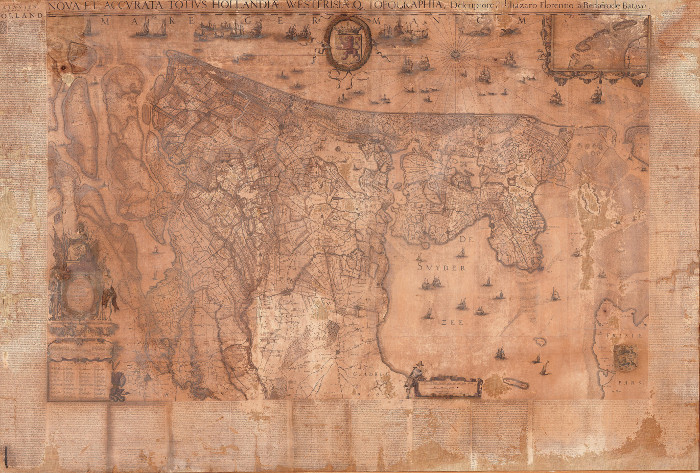
Designed by Balthasar Florisz. van Berckenrode in 1620
Published later by Willem Jansz. Blaeu
Hoorn, Westfries Museum
The Map of the Netherlands
A work that, almost certainly was bought by Van Ruijven is the small and brilliant painting now in the Frick Collection, New York, and still known by the title given to item 2 in the 1696 sale catalogue, "Soldier with a laughing girl," there described as "very fine."
It seems, at first, surprising that one man should have painted both the Dresden Procuress and, probably very shortly after, the Frick Soldier and Laughing Girl. They are not only so different in scale (the Frick painting being less than one-eighth the size of the Dresden picture) but quite at odds in their appeal to the viewer. In turning from the theatrical scale of The Procuress to something approaching the miniature, Vermeer removes his viewer from the awareness of his actors. Instead, the viewer becomes an eavesdropper, as it were, an unseen observer peering through the keyhole, or the crack in the shutter. This effect is established by a number of devices. In few of the mature works do Vermeer's characters betray any sense that they are overlooked. Often, they are engrossed in some demanding task or activity. In the Frick canvas, the couple are clearly absorbed in each other. Yet the spectator's viewpoint is intimately close, as the disparity in scale between the two betrays. The officer looms large, the girl, though seated within his grasp, just round the corner of the table, is diminutive, almost remote. It is an effect that photographs taken close-up with a wide-angle lens have made familiar. And it is one of the characteristics of Vermeer's compositions that had led art historians to argue that he used a camera obscura. (Another feature that suggests the use of a camera obscura is the brilliant, sparkling character of the light reflected from the girl's features, clothing and, most characteristically, by her hands and glass.) But these characteristics do not appear merely to be a consequence of the use of the camera. They become exemplary of the distinctive character of the cabinet picture. Instead of the picture being a fictional extension of the interior within which we stand, and in which we can imagine ourselves entering bodily, it offers a vision of an alternative interior from which we are necessarily excluded, except in imagination.
The Frick painting has this quality. We focus on the small image and are drawn to attend minutely to the drama we discover there. But what is happening? Is anything happening? Is it not simply a banal routine occasion? How much of the painting's magic lies simply in its virtuoso brilliance, the delicate precision of its rendering? Is not any story, any drama, we may choose to impose on this simple image no more than a consequence of our own inclination to fantasize? These are not trivial issues, for on their resolution will depend our sense of the weight of Vermeer's imaginative achievement. There are various circumstances, external and internal, that may illuminate this question.
The subjects of the Soldier, the Girl Interrupted and the drinking scenes at Berlin and Brunswick follow closely the genre convention of the time. Vermeer is never quite at home with it; his impersonality and his detachment sit a little incongruously on the careless air which the subjects affect. As his deliberation and his diffidence become more evident they give rise to curious inconsistencies of style. The subject of this picture has an evident relation to De Hooch. A rudimentary version of the soldier appears in one of his earliest military scenes (fig. 2), painted ten years or so earlier, and the evolution of the figure may be clearly traced in succeeding works. Often De Hooch seats him opposite a woman in a linen hood and more than once he serves to enclose a composition, shrouded as here in shadow. There are several versions of the group (a remarkable example is at Dublin) (fig. 4) from any of which Vermeer might have derived it in very much the form which it takes in the Frick picture. De Hooch himself doubtless owed the notion to the painters of Haarlem; such cavaliers were a part of their common stock. The device of enclosing the composition with a darkened figure outlined against the light is equally characteristic of them; among the artists who used it was J. van Velsen who worked in Delft.
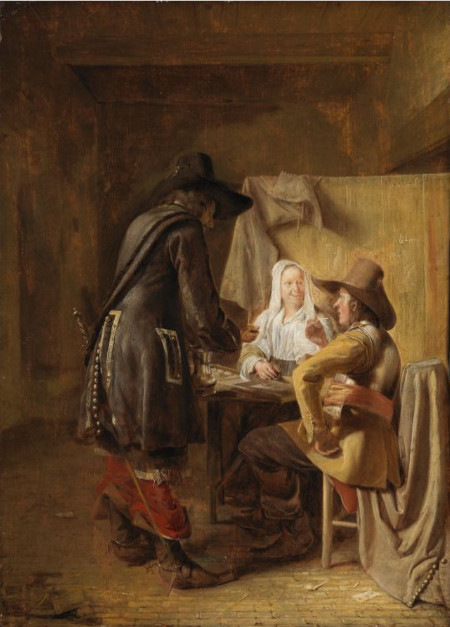
Pieter de Hooch
c.1652–1655
Oil on wood panel, 45 x 33.5 cm.
National Museum of Ireland, Dublin
Other elements in the Soldier and Laughing Girl were of more lasting use to the painter; his architecture and the light which floods it appear here in their mature form. The enclosing wall parallel to the plane of the picture and the windows on the left receding obliquely towards it make up the unvarying which he held throughout his work. This consistency in itself yields little evidence about the painter; the light in his interiors falls almost invariably from the left but it would not be easy to find a genre picture by one of his lit very definitely in any other way. The interiors of Rembrandt, rustic and hoary, radiant with piety and learning, and those of the meanest: Frans Hals and Dou share an architecture that is essentially the Vermeer adheres to it conservatively. The opening vistas which were a theme of De Hooch seem, although one of his variations is lost, hardly more interest for him than the shadowy spaces that Ter Borch was popularizing as a setting for elegant society. Few Dutch painters, but none less so than Vermeer, expended originality on innovation for its own sake.
The convention of form which Vermeer took up was of about thirty years' standing; the works of Rembrandt and the style which Dou derived from them, the painting of Haarlem under the influence of Frans Hals and the courtly cabinet pieces of the thirties, as well as reflections of the proliferating architectural fantasies of the perspective all contributed to it. One can trace in Vermeer's clear and rigid rectangle of space another sign of his acute eye for the essence of the varied elements in his tradition. The more elaborate of his last works tend towards the pattern propagated by the painters of Leiden. But there is no doubt that in the form, as in the figure motif, which he adopts in the Soldier and Laughing Girl one origin predominates, the school of Haarlem. Perhaps he owed it to the same immediate example, that of Pieter de Hooch. Vermeer's pattern is very close to a picture called The Card Players. The Delft painters may have drawn the suggestion from many sources; a number of their contemporaries arrived at similar solutions at about the same rime or a little earlier. De Hooch elaborated the structure in later works but he did not develop it. The form of The Card Players was one of the many fertile arrangements which he lighted on during his remarkable period of vitality. It would indeed be hard to imagine the unique potentialities of this hollow cube of lighted space if we had not Vermeer's mature pictures to help us.
Evangelos Livieratos and Alexandra Koussoulakou
"Vermeer's maps: a new digital look in an old master's mirror"e-Perimetron, Vol.1, No. 2, Spring 2006, pp. 138–154
The links of Cartography to Art and culture are as old as the field itself. The art of painting has always been present within maps, which, in turn have always been regarded as a combination of scientific and artistic skills. One of the most prominent examples of the harmonic duality of maps as scientific tools and objects of culture is witnessed in the Netherlands during the seventeenth century, when the Dutch were world leaders in the field of cartographic production. This period is also known as the golden century of the country: state power and world dominion were combined with progress in science and in arts. Dutch mapmakers of the time were usually combining more skills: they were surveyors, cartographers, painters of landscapes and even more. On the other hand, many seventeenth-century Dutch painters such as Hals, Vermeer, Ter Borch, De Hooch, Steen, Ochtervelt, Maes and others, introduced depictions of real maps into their works and decorated their interiors with maps for symbolic or allegorical reasons. A typical example is Johannes Vermeer; in his painting 'Officer and laughing girl' (~1660) an officer and a young girl are placed in an interior, sitting at a table in front of a window. On the wall behind the girl a large map (fig. 5) is hanging, occupying a large part of the painting and being equally important as the rest of the scene.
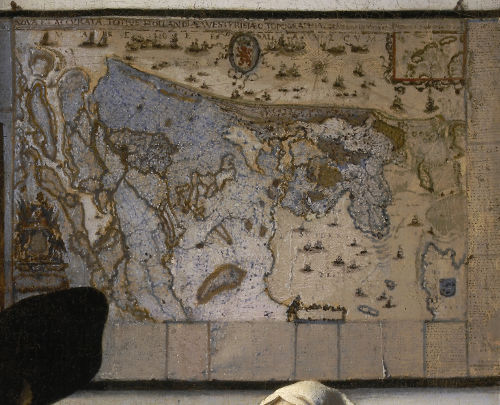 fig. 5
fig. 5 Johannes Vermeer
c. 1657–1660
Oil on canvas, 50.5 x 46 cm.
Frick Collection, New York
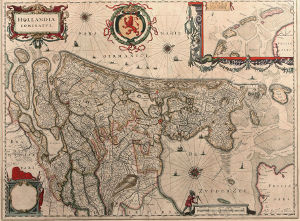
Willem Janszoon Blaeu
Amsterdam, 1635
The map on the painting depicts part of the Netherlands; its remarkable similarity with the original topographic map (fig. 6) of its time (c. 1620) makes comparison processes a real challenge. Such a comparison is nowadays made much easier than in the past with the tools offered by the new technologies. Issues of interest for the history of cartography reveal new dimensions through the use of these tools. A typical example concerning the study of old maps is the deformation analysis
of those maps. Such a deformation analysis was attempted, for the two maps mentioned before (i.e. the map on the painting and its original -old- topographic counterpart). In this paper the comparative method of analysis is applied on the 'painted' map and its actual counterpart, by transforming optimally one onto the other. Apart from the analytical and digital component of the process, an interesting result is the visual representation of the transformation (dynamic morphing) from one map to the other. This revealed some remarkable indications about the method followed by the artist (use of the camera obscura) in his painting.



